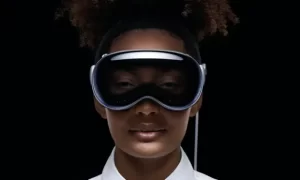
Apple has lifted the lid on the worst kept secret in Silicon Valley and revealed the Vision Pro, a $3,499 VR headset.
“With Vision Pro, you’re no longer limited by a display. Your surroundings become an infinite canvas,” the Apple chief executive, Tim Cook, said. “Vision Pro blends digital content into the space around us. It will introduce us to Spatial Computing.”
The headset allows users to interact with “apps and experiences”, the Apple vice-president of human interface design, Alan Dye, said, in an augmented reality (AR) version of their own surroundings or in a fully immersive virtual reality (VR) space.
“Apple Vision Pro relies solely on your eyes, hands and voice,” Dye said. “You browse the system simply by looking. App icons come to life when you look at them; simply tap your fingers together to select, and gently flick to scroll.”
A feature called “EyeSight” will show users’ eyes on the front screen when they are in an AR mode, simulating a transparent screen and letting them more naturally interact with those around them, but will show a blurred version of a VR experience to indicate to others when they are not present in the room.
“Because you can see the world clearly when wearing Vision Pro, you remain present in your space,” Apple said. “You can review your to-do list and notes, review your next trip in safari, and play music while you type. It works seamlessly with familiar Bluetooth accessories, and you can even bring your Mac wirelessly into Apple Vision Pro just by looking at it.”
As well as applications built from the ground up for the device, Vision Pro will also run apps built for iOS, appearing as a floating screen in front of the user. The company is pitching the device as a powerful but compact replacement or augmentation for a user’s existing devices.
One demonstration, for instance, showed a user having a FaceTime conversation in AR with their contacts appearing in screens floating around them. For that experience, Vision Pro creates a representation of you using machine learning, Apple said, to make a digital face that “dynamically matches your facial and hand movements”.
As an entertainment device, Apple is keen to highlight the device’s “3D camera”, which users can use to take “spatial photos”, as well as more conventional VR experiences such the ability to watch a movie in a virtual cinema or play Apple Arcade video games. “There is no other device in the world that can deliver this quality of 3D experience,” the company said.
“Apple Vision Pro will change the way we communicate, collaborate, work and enjoy entertainment,” Cook added. The company compared the device to a new TV, surround sound system, powerful laptop, and games console all in one – before revealing its price, an eye-watering $3,499, $500 more than the already high pricetag rumoured in the run-up to the event. The device will ship “early next year” in the US, Apple said. No dates or prices were given for other regions.
The Disney chief executive, Bob Iger, said the company would be building new experiences specifically for the device, showing examples such as Star Wars-themed virtual cinemas, AR replays for sports and a Marvel VR experience. “We believe Apple Vision Pro is a revolutionary new platform that can make our vision a reality,” Iger said. “The thing that struck me most was how it will allow us to create deeply personal experiences that bring our fans closer to the characters they love.”
On a tech level, the device has the equivalent of a 4k screen for each eye, using pixels 64 times smaller than those in an iPhone, with the same M2 processor as in the company’s MacBook laptops, paired with an “R1” chip purpose built for the headset.
Even before the device was officially announced at its worldwide developers conference, Apple’s rivals were competing to react to its entry into the space.
Mark Zuckerberg went on the offensive, announcing the Meta Quest 3, a $499 follow-up to its flagship VR device, in an Instagram post the week before Apple’s event – an announcement clearly pulled forward from the company’s 27 September Connect event.
HTC, which produces the Vive, took a more conciliatory approach, with its cofounder Cher Wang putting out a pre-emptive statement saying she was “thrilled to extend a warm welcome to Apple as they venture into the vibrant XR [extended reality] community”.
Apple may be late to the market with a VR headset, but no one wants to emulate Ed Colligan, the chief executive of the then leading PDA maker Palm, who responded to the launch of the iPhone in 2006 by telling reporters: “We’ve struggled for a few years here, figuring out how to make a decent phone. The PC guys are not going to just, you know, knock this out. I guarantee it.”
Read more:
Apple reveals Vision Pro AR headset at its worldwide developers conference

